Canon EF 100 mm f/2.8 L Macro IS USM
3. Build quality and image stabilization
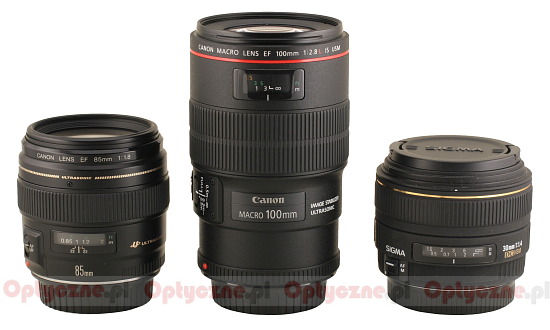 |
The barrel’s workmanship quality is difficult to fault. We deal here with a metal mount, a magnesium alloy body and a rubber-coated ring. The lens is completely weather sealed. On focusing only the inner elements change their positions inside the barrel, the external elements stand still; the front element ends almost evenly with the barrel’s edge and is surrounded by a non-rotating filter thread 67 mm in diameter; the rear element is hidden more than 1 cm inside the mount casing.
Please Support UsIf you enjoy our reviews and articles, and you want us to continue our work please, support our website by donating through PayPal. The funds are going to be used for paying our editorial team, renting servers, and equipping our testing studio; only that way we will be able to continue providing you interesting content for free. |
- - - - - - - - - - - - - - - - - - - - - - - - - - - - - - - - - - - - - - - - - - - - - - - -
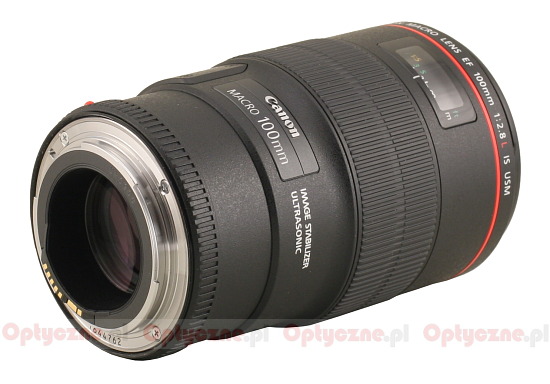 |
Such a solution has its pros and cons. You must remember that, on passing to minimal focus, which amounts to 0.3 m here, the focal length will get shorter and the lens’s fastness will decrease near even f/5.6. You can see it directly when you look inside the barrel - going to about 0.5 m you can notice an aperture appearing in the optics’ field and it gets even narrower when you pass to 0.3 m. It is also good to remember that these 0.3 m are just the minimal focus value, calculated from the lens’s main plane. In reality, shooting in the 1:1 scale, the lens’s end is positioned only 13 cm from its subject.
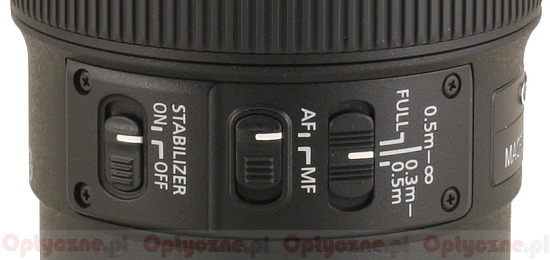 |
There are several controls on the lens’s barrel. The first one limits the autofocus working range (we can choose from 0.3-05 m, 0.5 m – infinity, and FULL ranges), the second helps us with the focusing mode choice (AF/MF) and the third one controls stabilization (STABILIZER ON/OFF). In the middle of the lens we find a broad, comfortable and ribbed manual focus ring. You can’t complain about the comfort of work but there’s one “but” to be mentioned here. To run through the scale you need an almost 160 degrees ring turn. That’s quite a lot but the problem is that the most part of this movement concerns the macro range. In the normal work mode the passage from 0.5 m to infinity requires a 45 degrees turn, from 1 meter to infinity – about 15 degrees turn (so literally just 6-7 ribs on the ring). Such a construction makes you almost totally dependent on autofocus in the normal work mode. Any attempts to focus manually in the range from 1 meter to infinity automatically fail (unless we work at the f/11-f/16 apertures level) because even minimal ring movement is translated into a big leap in the focus position so the pictures are far from sharp. We definitely discourage and advise against any manual portrait photography attempts. Perhaps Canon assumes that for portraits you have classic fast portrait lenses and a macro lens is designed for macro pictures, full stop.
Between the manual focus ring and a red strip, characteristical for L series lenses we find a clear distance scale window in both feet and meters.
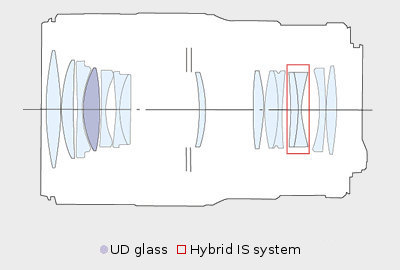
The Canon EF 100 mm f/2.8L IS USM is optically the most complex macro 100 lens currently on the market. It consists of 15 elements in 12 groups. One element was made of low-dispersion glass UD (Ultra Low Dispersion). Inside, we also find a circular aperture with nine diaphragm blades, which can be closed down to f/32.
The buyer gets both caps, a hood and a soft case in box. What a pity a tripod mount ring is not included. Especially that, right after the mount, there’s a place where you can attach it.
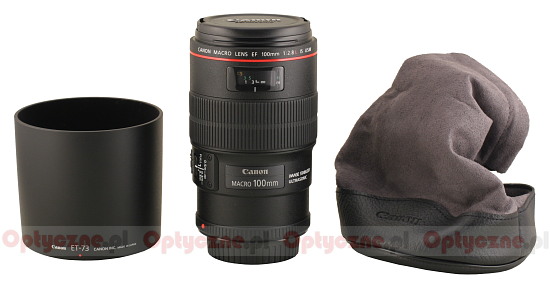 |
Stabilization
As the manufacturer claims, the new hybrid picture stabilization system ( Hybrid IS) can offer even a four-degree correction, eliminating unwanted camera shakes during normal photographing. Low friction ceramic balls support the elements movements, ensuring smooth work required during the compensating for camera shakes in the macro mode. Hybrid IS corrects linear (shift) camera shakes – occurring by close-ups – and also angular (rotational) shakes. The Hybrid IS image stabilization allows us to use 2 additional aperture degrees by 1:1 enlarging and it makes your work more efficient by passing to farther distances.
To check how this new stabilization work, we performed our standard test procedure. We photographed a scene from a distance of about 0.7-0.8 meter this time, taking about 25 to 40 shots for every exposition time from the range of 1/160 – 1/3 second with the stabilization on and off. Every photos sample was assessed according to the number of blurred pictures. The number of such pictures compared to the overall number of pictures taken at the given time, understood as a time exposition function in EV ( where 0 EV corresponds to the 1/100 s) was presented on the graph below.
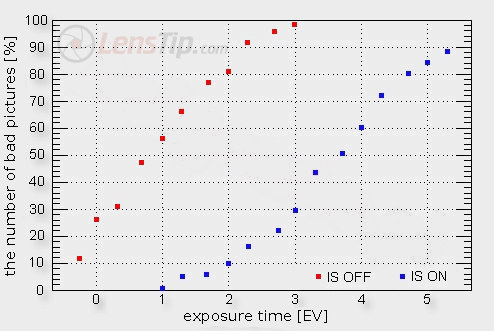
As you see we deal here with the solid result at the level of 3 EV. In fact it is in full accordance with the producer’s claims. The stabilization was supposed to be at 2 EV efficiency level in the case of 1:1 scale and at 4 EV level by photographing without a blow-up. The distance, used in the test, is exactly in-between those types of work so also the result of 3 EV, being right in the middle of the declared 2 and 4 EV values, we should consider as right and good.






